While Serbia’s Prime Minister Aleksandar Vucic is set on transforming Belgrade into the Dubai of the Balkans, as with many capital cities, the arteries to the outskirts are surrounded by remote streets where people pushed to the edges of society are trying to make a living. After leaving behind old Belgrade across the massive Pancevo Bridge, on the north bank of the Danube, one comes to Krnjaca, one of Belgrade’s isolated neighborhoods that today reflects the legacies of war in former Yugoslavia.
“I wouldn’t wish even for my enemy to have the fate of living in these conditions,” says Zivan Zivkovic.
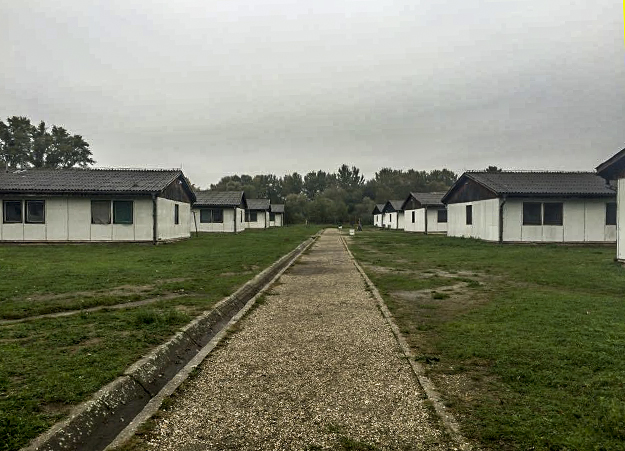
The collective center at Krnjaca on the outskirts of Belgrade was established an emergency response to accommodate Serbs fleeing the region’s armed conflicts in the 1990s.
Zivkovic is a displaced person from Kosovo, living in the last remaining collective center in Belgrade. Evoking imagery of concentration camps, a row of brutal barracks accommodates internally displaced people and refugees from the armed conflicts in former Yugoslavia. With an uncertain status and no possibility of returning home, these people are living in limbo.
Leaving Home Behind
As Nato peacekeeping troops entered Kosovo in June 1999 and Serb forces steadily withdrew, huge numbers of Kosovo Serbs ran away towards the north. They feared reprisals by the Kosovo Liberation Army and by Albanians who were returning to their liberated homes following the ethnic cleansing by Serbian forces.
According to statistics from United Nations Refugee Agency (UNHCR), around 200,000 Kosovo Serbs became Internally Displaced People (or IDPs) in Serbia overnight. (As the UN still hasn’t recognized Kosovo, displaced people in Serbia are still referred to as IDPs — the same as the displaced people within Kosovo — rather than as international refugees who have crossed a unanimously recognized state border).
Today, 16 year after the war, few of those displaced have returned, despite the work of numerous NGOs and significant financial investment by the international community and Kosovo’s government. Discouraged by feelings of insecurity and safety, political instability and a lack of adequate assistance to ensure the sustainability of their return, it is estimated that only 11,194 Serbs have moved back to Kosovo; less than six percent of those who left.

Zivan Zivkovic and his wife left their home in the village of Mushtisht, near Suhareka, in June 1999. They now share a tiny room in Krnjaca’s collective center.
“Everything was great until 1991. And then, politics destroyed us and you [Albanians],” Zivkovic says, while sitting at the small coffee table in his tiny room at Krnjaca’s collective center, which barely accommodates him and his wife.
Zivkovic left his beloved Mushtisht, a village in the Municipality of Suhareka, on June 16, 1999. “Mushtisht is the most beautiful place in Kosovo,” recalls Zivkovic, wistfully. “The valley with houses under the Sharr Mountains. It is so beautiful.” As he speaks, his eyes fill with tears at the memory of his lost former home.
“I built three houses for my three sons. The daughter is my fourth child, but as you know the tradition in Kosovo, the daughters don’t inherit the properties.”
The emotional connection with his land has stopped him from selling his properties, despite the fact that he has been living in Serbia for the past 16 years. “I loved that place, and all the nationalities that lived there,” he says. “We used to hang out a lot with the Albanian neighbors. They are very hospitable people. We would go to their houses for Eid celebrations and they would come for Christmas,” he recalls. “And we would be the first people next to each other during weddings and funerals.”
Zivkovic has visited his properties many times since the end of the war as different agencies have organized many trips for displaced people to various locations in Kosovo. The trips include taking the IDPs to Prizren and its neighboring Suhareka, but not to the Mushtisht village. Zivkovic says that his local Albanian friends would come to pick him up in Suhareka and take him to visit his home. The last time he visited his village was three years ago; he has subsequently suffered a stroke and his complicated health doesn’t allow him to travel by bus anymore.
Within the collective center Zivkovic’s two sons live in the rooms next to him, with their families. The third son was killed in a car accident in 1992. His widowed daughter-in-law is also accommodated at the collective center, with their children.
The barracks of Krnjaca accommodate 175 Serbs; 90 Serb refugees from Bosnia and Herzegovina and Croatia and 85 displaced Serbs from Kosovo. All carry the burden of shifted power relations after Serbian forces withdrew from the locations that they occupied in former Yugoslavian territories.
Supported by the Commissariat for Refugees and Immigration, a Serbian governmental department, collective centers provide a roof over their heads, heating and free meals. But, Krnjaca might be the most deplorable center of all, since it was established as an emergency response camp during the ‘90s when thousands of Serbs fled the armed conflicts in their places of origin.
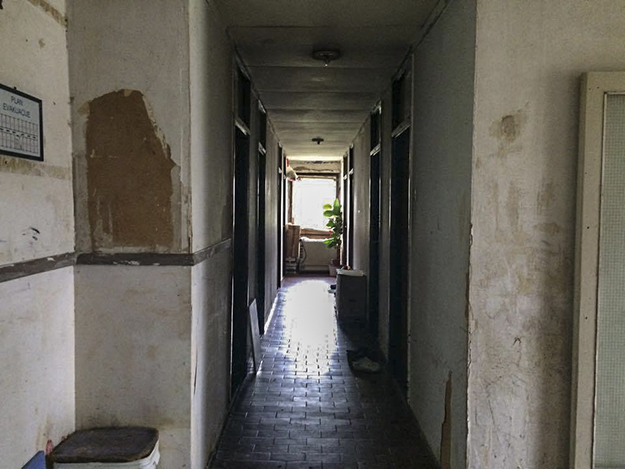
Conditions in Krnjaca’s collective center are thought to be amongst the worst in any of the centers accommodating IDPs from the conflict in Kosovo.
Zivkovic is a University of Belgrade Faculty of Transport and Traffic Engineering graduate and was the transport director at IGK Balkan, Rubber and Chemical Industry in Suhareka before the war. Now his only income is the pension that he gets every month by post, which is enough only for food — he tends to buy his own as the free meals provided are “very bad.” “Compared to other collective centers, they were paradise and here is like hell,” he says. “Thank God we have the heating, otherwise there is nothing else.”
Olivera Vucic from the Commissariat said that there are not currently enough international funds to provide sustainable solutions for IDPs at collective centers. Still, from the estimated 700 collective centers that were in Serbia in 1996, today that number has decreased to 10, which currently accommodate 722 people. There are also eight collective centers in Kosovo, accommodating 353 IDPs, including Serbs, Roma and some Albanians.
Seeking Solutions
Narasimha Rao, head of mission of UNHCR Kosovo, told Kosovo 2.0 that the ultimate aim is to find a “durable solution” for all IDPs, depending on what the most appropriate action is for each individual that is affected by displacement. “The most affected ones are the ones in collective centers; those who don’t have properties and remain as IDPs in official government books,” he said. “They are still in the limbo: They don’t belong to Serbia, they don’t belong to Kosovo.”
Rao explained how the “durable solution” can sometimes be found in the place of displacement, where IDPs can be integrated and enjoy the rights of every citizen. The other solution is their right to return to their place of origin.
According to UNHCR 97,000 displaced people from Kosovo — a little under half of the overall IDP population — are still in need of a “durable solution” in Serbia in order to be fully integrated. For people at collective centers, this solution includes finding appropriate housing as well as employment in order to allow their socio-economic integration.
Internally displaced people have the same rights and freedoms under international laws as do the other citizens of their country. Still, long after the war’s end, many are unable to enjoy those rights, which remain vulnerable in both Serbia and Kosovo. Poverty in the developing countries, where unemployment rates are high across the whole population, has contributed to the marginalization of IDPs and their access to employment, thereby affecting the full integration of displaced people. According to the 2012 “Citizens’ Attitudes on Discrimination in Serbia” report by the United Nations Development Programme, IDPs in Serbia are amongst the most discriminated against groups, together with Roma, women, older people, and people with disabilities.
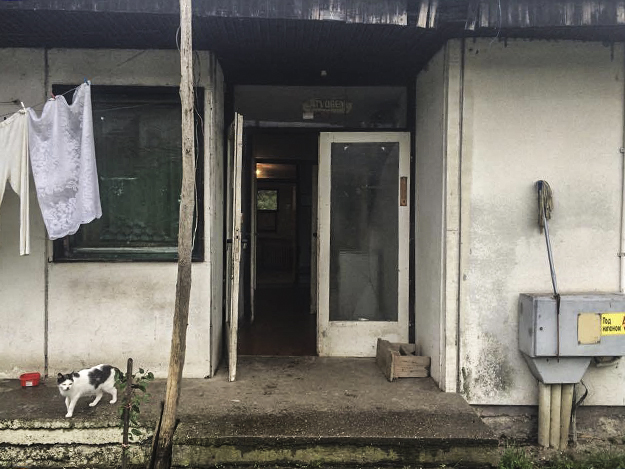
The barracks at Krnjaca accomodate 175 Serbs, including 85 people who have been displaced from Kosovo.
IDPs in both Kosovo and Serbia are entitled to social welfare rights, just as other citizens of each country are. However, a 2014 analysis by Praxis found that IDPs living in some collective centers in Serbia are unable to exercise this right; some social welfare centers consider that the minimal level of social security is satisfied for this category of citizens as they are provided with accommodation and meals.
“We can’t say that IDPs are completely excluded in society, but it is felt is some particular environments,” Sinisa Volarevic, program coordinator at the Center for Migration of the Belgrade-based NGO, Grupa 484 told Kosovo 2.0. “In some places people are less accepted. Then, it is a fact that IDPs are integrated more slowly into poor societies.”
The dissolution of former Yugoslavia shed a further light on the identity differences between communities and places. Often displaced people from Kosovo have felt shunned and treated as second-class citizens in Serbia, just because they are from Kosovo; according to a survey conducted by Grupa 484, around 20 percent of IDPs who experienced discrimination, felt that their treatment was as a result of being from Kosovo.
It’s an experience that resonates with Zivkovic. “In the beginning it was tough. They would call us ‘shiptars,’ although we are Serbs,” says Zivkovic, referring to the well known derogatory Serbian term for Albanians. “If somebody got a little drunk, he would say, ‘where are you shiptar motherfucker?’ It is not important if someone says, shiptar or serb, but i don’t like it when somebody curses my mother, or father. I don’t accept that.”
On the other hand, all the people interviewed for this article point out that Serbia has proved a welcoming home for thousands of IDPs who have managed to become well integrated into society. This has been particularly true for younger generations, since they don’t have the same nostalgic feeling about home in Kosovo as do their older family members.
Obstacles on the Road to Return
As part of UN Security Council resolution 1244, and since 2008 under Kosovo’s Constitution, people have the right to return to their place of origin. Immediately after the war, the international organizations were largely focused on supporting and assisting Albanian refugees who had returned to Kosovo and on reconstructing the devastated country.
In 2003 more concrete projects for the repatriation of minorities started to take place. However the March 2004 riots saw Albanians burning hundreds of houses belonging to Serbs as well as around 30 Orthodox churches and monasteries, causing more insecurity for many about living alongside the majority Albanian population. An estimated 4,000 Serbs were displaced from their homes as a result of the unrest.
The low return rate of IDPs moving back to Kosovo shows that there are still many remaining obstacles and concerns for those who may want to return. “We are encouraging that people don’t need to come back to their place of origin, but that they can be brought back in any other place where they feel secure,” said Rao. Most Serbs who have returned have preferred to restart their lives within Kosovo in a Serbian majority-town or village, instead of going back to their place of origin.
“I would return if I had the possibility, the freedom of movement, if there were more [Serbian] people there,” said Jevto Zivanovic, another man from Mushtisht village who is today living at Krnjaca’s collective center. “I constantly see some shootings and bombs on television.”
In reality, the freedom of movement and security issues have dramatically improved during recent years in Kosovo, but the perception of insecurity endures for many. It is a perception that is willfully reinforced by Serbia’s mainstream media, which tends to feed the notion that Kosovo Serbs are threatened by Kosovo Albanians, with many stories being unapologetically biased, unbalanced and without any verification of facts.
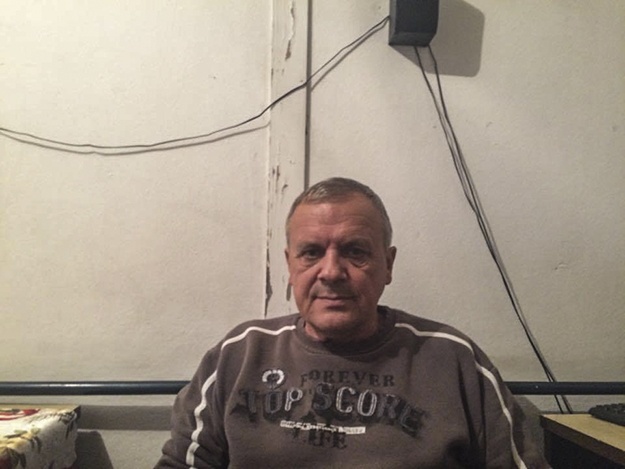
Jevto Zivanovic, who was displaced from Mushtisht village near Suhareka, has reservations about returning to Kosovo.
According to a recent report compiled by the Albanian Media Institute entitled, “Reporting Neighbours in Balkan Media,” the Serbian media — and particularly the tabloids — presents Albanians more disfavorably than it does any other ethnicity in the region. The same report notes that the Kosovar media may reinforce certain persistent stereotypes toward Serbia, such as the belief that there is only hate towards Albanians from the Serbian side.
With the Serbian political elite and Serbian representatives in Kosovo continuously drip-feeding the media with the partisan rhetoric of needing to protect Serbs in Albanian-majority Kosovo, it is not hard to see how Zivanovic, and many others like him who have never returned to Kosovo since the war, can be easily misinformed about the situation on the ground.
One of the practical obstacles facing potential returnees is the issue of property rights for displaced people. In many cases, properties that have been left seemingly abandoned by Serbs, have been occupied by others in their absence. “If they can go back to reclaim their properties everything would come into order,” emphasized Vucic from the Commissariat in Belgrade.
Responsibility for receiving and registering claims for disputed properties as a result of the armed conflict falls to the Kosovo Property Agency (KPA); cases should then be resolved through the Kosovo Property Claims Commission. According to the KPA’s latest figures, in 2015 alone the agency has executed 784 evictions, while 946 evictions are pending.
But the practical ability of the KPA to solve the issue of returning properties to their original owners is limited. In many cases, the owners of the properties hesitate to move back into their house, even after it has been returned to them, meaning that the illegal occupants — usually local Albanians — ‘reoccupy’ the empty building.
KPA, working alongside the police, has the mandate to evict illegal occupants twice, but any further complaint is sent to the Kosovo Police for resolution in the courts. Here, complaints join hundreds of similar cases in a backlogged judicial system; according to KPA, out of a total of 389 cases initiated by the prosecution to date, 193 cases are still ongoing.
UNHCR’s Rao said that the Minister for Communities and Return in Kosovo has been advocating the need to establish a specialist court that would deal specifically with property cases. Kosovo 2.0 contacted the Ministry for further details and to discuss its strategies on the issues facing returnees but it failed to respond to multiple requests for interview.
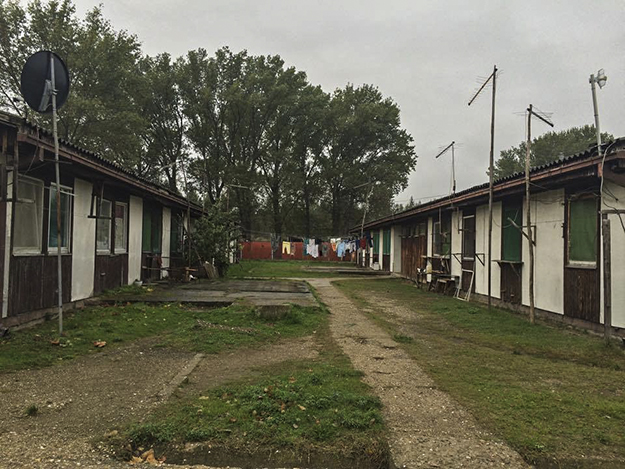
Part of the collective center at Krnjaca now accommodates refugees who are fleeing conflict in the Middle East.
Back in Belgrade, the practical problems involved in a potential return seem a long way off for many of the displaced people from Kosovo who are stuck in the Krnjaca collective center. With the new wave of refugees from the Middle East now occupying the other side of the camp, as well as the focus of Serbia’s authorities and the international community at large, Krnjaca’s original occupants feel even more forgotten and marginalized than ever before.
This story has been conducted as part of the Kosovo Serbia: LIVE project, financed by the European Union, as part of Civil Society Support 2013. The content and views presented in this story are the exclusive responsibility of the author and do not necessarily portray the views and stances of the European Union.
Photos: Dafina Halili

